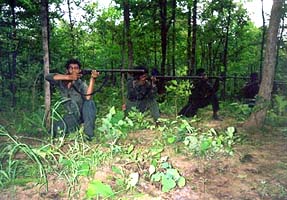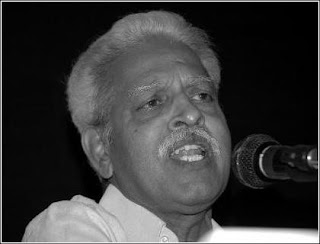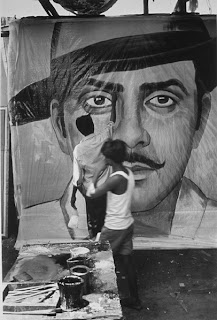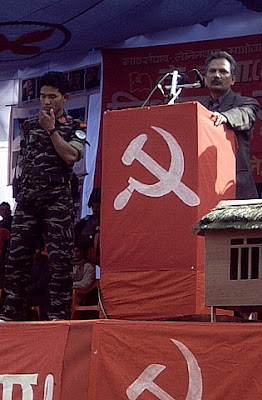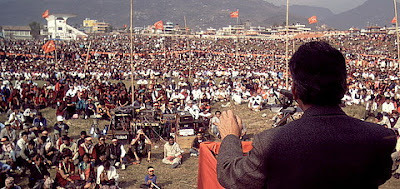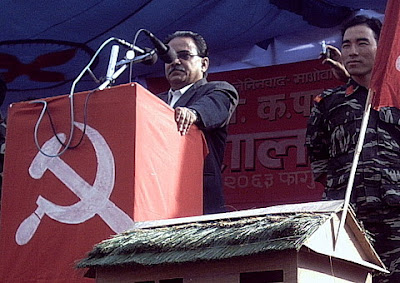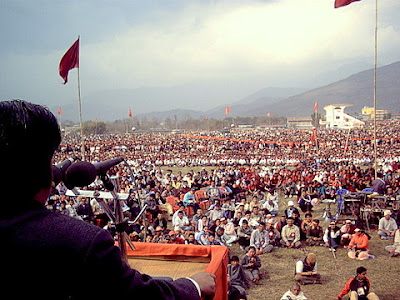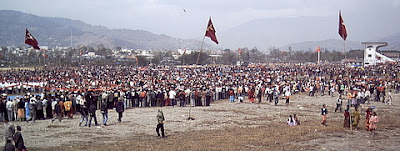EXCLUSIVE INTERVIEW'It’s outright war and both sides are choosing their weapons'Chhattisgarh. Jharkhand. Bihar. Andhra Pradesh. Signposts of fractures gone too far with too little remedy. Arundhati Roy in conversation with Shoma Chaudhury on the violence rending our heartland
There is an atmosphere of growing violence across the country. How do you read the signs? In what context should it be read?You don’t have to be a genius to read the signs. We have a growing middle class, reared on a diet of radical consumerism and aggressive greed. Unlike industrialising Western countries, which had colonies from which to plunder resources and generate slave labour to feed this process, we have to colonise ourselves, our own nether parts. We’ve begun to eat our own limbs. The greed that is being generated (and marketed as a value interchangeable with nationalism) can only be sated by grabbing land, water and resources from the vulnerable.
What we’re witnessing is the most successful secessionist struggle ever waged in independent India — the secession of the middle and upper classes from the rest of the country. It’s a vertical secession, not a lateral one.They’re fighting for the right to merge with the world’s elite somewhere up there in the stratosphere. They’ve managed to commandeer the resources, the coal, the minerals, the bauxite, the water and electricity. Now they want the land to make more cars, more bombs, more mines — supertoys for the new supercitizens of the new superpower. So it’s outright war, and people on both sides are choosing their weapons. The government and the corporations reach for structural adjustment, the World Bank, the ADB, FDI, friendly court orders, friendly policy makers, help from the ‘friendly’ corporate media and a police force that will ram all this down people’s throats.
Those who want to resist this process have, until now, reached for dharnas, hunger strikes, satyagraha, the courts and what they thought was friendly media. But now more and more are reaching for guns. Will the violence grow? If the ‘growth rate’ and the Sensex are going to be the only barometers the government uses to measure progress and the well-being of people, then of course it will. How do I read the signs? It isn’t hard to read sky-writing. What it says up there, in big letters, is this: the shit has hit the fan, folks.
You once remarked that though you may not resort to violence yourself, you think it has become immoral to condemn it, given the circumstances in the country. Can you elaborate on this view?I’d be a liability as a guerrilla! I doubt I used the word ‘immoral’ — morality is an elusive business, as changeable as the weather. What I feel is this: non-violent movements have knocked at the door of every democratic institution in this country for decades, and have been spurned and humiliated. Look at the Bhopal gas victims, the Narmada Bachao Andolan. The nba had a lot going for it — high-profile leadership, media coverage, more resources than any other mass movement.
What went wrong? People are bound to want to rethink strategy. When Sonia Gandhi begins to promote satyagraha at the World Economic Forum in Davos, it’s time for us to sit up and think. For example, is mass civil disobedience possible within the structure of a democratic nation state? Is it possible in the age of disinformation and corporate-controlled mass media? Are hunger strikes umbilically linked to celebrity politics? Would anybody care if the people of Nangla Machhi or Bhatti mines went on a hunger strike? Irom Sharmila has been on a hunger strike for six years. That should be a lesson to many of us. I’ve always felt that it’s ironic that hunger strikes are used as a political weapon in a land where most people go hungry anyway. We are in a different time and place now.
Up against a different, more complex adversary. We’ve entered the era of NGOs — or should I say the era of paltu shers — in which mass action can be a treacherous business. We have demonstrations which are funded, we have sponsored dharnas and social forums which make militant postures but never follow up on what they preach. We have all kinds of ‘virtual’ resistance. Meetings against SEZs sponsored by the biggest promoters of SEZs. Awards and grants for environmental activism and community action given by corporations responsible for devastating whole ecosystems. Vedanta, a company mining bauxite in the forests of Orissa, wants to start a university.
The Tatas have two charitable trusts that directly and indirectly fund activists and mass movements across the country. Could that be why Singur has drawn so much less flak than Nandigram? Of course the Tatas and Birlas funded Gandhi too — maybe he was our first NGO. But now we have NGOs who make a lot of noise, write a lot of reports, but whom the sarkar is more than comfortable with. How do we make sense of all this? The place is crawling with professional diffusers of real political action. ‘Virtual’ resistance has become something of a liability.
We are in the era of sponsored dharnas and NGOs the sarkar is comfortable with. The place is crawling with professional diffusers of real political action
There was a time when mass movements looked to the courts for justice. The courts have rained down a series of judgements that are so unjust, so insulting to the poor in the language they use, they take your breath away. A recent Supreme Court judgement, allowing the Vasant Kunj Mall to resume construction though it didn’t have the requisite clearances, said in so many words that the questions of corporations indulging in malpractice does not arise! In the ERA of corporate globalisation, corporate land-grab, in the ERA of Enron and Monsanto, Halliburton and Bechtel, that’s a loaded thing to say. It exposes the ideological heart of the most powerful institution in this country. The judiciary, along with the corporate press, is now seen as the lynchpin of the neo-liberal project.
In a climate like this, when people feel that they are being worn down, exhausted by these interminable ‘democratic’ processes, only to be eventually humiliated, what are they supposed to do? Of course it isn’t as though the only options are binary — violence versus non-violence. There are political parties that believe in armed struggle but only as one part of their overall political strategy. Political workers in these struggles have been dealt with brutally, killed, beaten, imprisoned under false charges. People are fully aware that to take to arms is to call down upon yourself the myriad forms of the violence of the Indian State. The minute armed struggle becomes a strategy, your whole world shrinks and the colours fade to black and white. But when people decide to take that step because every other option has ended in despair, should we condemn them? Does anyone believe that if the people of Nandigram had held a dharna and sung songs, the West Bengal government would have backed down? We are living in times when to be ineffective is to support the status quo (which no doubt suits some of us). And being effective comes at a terrible price. I find it hard to condemn people who are prepared to pay that price.
You have been travelling a lot on the ground — can you give us a sense of the trouble spots you have been to? Can you outline a few of the combat lines in these places?Huge question — what can I say? The military occupation of Kashmir, neo-fascism in Gujarat, civil war in Chhattisgarh, mncs raping Orissa, the submergence of hundreds of villages in the Narmada Valley, people living on the edge of absolute starvation, the devastation of forest land, the Bhopal victims living to see the West Bengal government re-wooing Union Carbide — now calling itself Dow Chemicals — in Nandigram. I haven’t been recently to Andhra Pradesh, Karnataka, Maharashtra, but we know about the almost hundred thousand farmers who have killed themselves.
We know about the fake encounters and the terrible repression in Andhra Pradesh. Each of these places has its own particular history, economy, ecology. None is amenable to easy analysis. And yet there is connecting tissue, there are huge international cultural and economic pressures being brought to bear on them. How can I not mention the Hindutva project, spreading its poison sub-cutaneously, waiting to erupt once again? I’d say the biggest indictment of all is that we are still a country, a culture, a society which continues to nurture and practice the notion of untouchability. While our economists number-crunch and boast about the growth rate, a million people — human scavengers — earn their living carrying several kilos of other people’s shit on their heads every day. And if they didn’t carry shit on their heads they would starve to death. Some f***ing superpower this.
How does one view the recent State and police violence in Bengal?No different from police and State violence anywhere else — including the issue of hypocrisy and doublespeak so perfected by all political parties including the mainstream Left. Are Communist bullets different from capitalist ones? Odd things are happening. It snowed in Saudi Arabia. Owls are out in broad daylight. The Chinese government tabled a bill sanctioning the right to private property. I don’t know if all of this has to do with climate change. The Chinese Communists are turning out to be the biggest capitalists of the 21st century. Why should we expect our own parliamentary Left to be any different? Nandigram and Singur are clear signals. It makes you wonder — is the last stop of every revolution advanced capitalism?
Think about it — the French Revolution, the Russian Revolution, the Chinese Revolution, the Vietnam War, the anti-apartheid struggle, the supposedly Gandhian freedom struggle in India… what’s the last station they all pull in at? Is this the end of imagination?These are times when to be ineffective is to support the status quo. And being effective comes at a terrible price
The Maoist attack in Bijapur — the death of 55 policemen. Are the rebels only the flip side of the State?How can the rebels be the flip side of the State? Would anybody say that those who fought against apartheid — however brutal their methods — were the flip side of the State? What about those who fought the French in Algeria? Or those who fought the Nazis? Or those who fought colonial regimes? Or those who are fighting the US occupation of Iraq? Are they the flip side of the State? This facile new report-driven ‘human rights’ discourse, this meaningless condemnation game that we are all forced to play, makes politicians of us all and leaches the real politics out of everything.
However pristine we would like to be, however hard we polish our halos, the tragedy is that we have run out of pristine choices. There is a civil war in Chhattisgarh sponsored, created by the Chhattisgarh government, which is publicly pursing the Bush doctrine: if you’re not with us, you are with the terrorists. The lynchpin of this war, apart from the formal security forces, is the Salva Judum — a government-backed militia of ordinary people forced to take up arms, forced to become spos (special police officers).
The Indian State has tried this in Kashmir, in Manipur, in Nagaland. Tens of thousands have been killed, hundreds of thousands tortured, thousands have disappeared. Any banana republic would be proud of this record. Now the government wants to import these failed strategies into the heartland. Thousands of adivasis have been forcibly moved off their mineral-rich lands into police camps. Hundreds of villages have been forcibly evacuated. Those lands, rich in iron-ore, are being eyed by corporations like the Tatas and Essar. mous have been signed, but no one knows what they say. Land acquisition has begun.
This kind of thing happened in countries like Colombia — one of the most devastated countries in the world. While everybody’s eyes are fixed on the spiralling violence between government-backed militias and guerrilla squads, multinational corporations quietly make off with the mineral wealth. That’s the little piece of theatre being scripted for us in Chhattisgarh.
Of course it’s horrible that 55 policemen were killed. But they’re as much the victims of government policy as anybody else. For the government and the corporations they’re just cannon fodder — there’s plenty more where they came from. Crocodile tears will be shed, prim TV anchors will hector us for a while and then more supplies of fodder will be arranged. For the Maoist guerrillas, the police and spos they killed were the armed personnel of the Indian State, the main, hands-on perpetrators of repression, torture, custodial killings, false encounters. They’re not innocent civilians — if such a thing exists — by any stretch of imagination.
I have no doubt that the Maoists can be agents of terror and coercion too. I have no doubt they have committed unspeakable atrocities. I have no doubt they cannot lay claim to undisputed support from local people — but who can? Still, no guerrilla army can survive without local support. That’s a logistical impossibility. And the support for Maoists is growing, not diminishing. That says something. People have no choice but to align themselves on the side of whoever they think is less worse.
But to equate a resistance movement fighting against enormous injustice with the government which enforces that injustice is absurd. The government has slammed the door in the face of every attempt at non-violent resistance. When people take to arms, there is going to be all kinds of violence — revolutionary, lumpen and outright criminal. The government is responsible for the monstrous situations it creates.
‘Naxals’, ‘Maoists’, ‘outsiders’: these are terms being very loosely used these days.‘Outsiders’ is a generic accusation used in the early stages of repression by governments who have begun to believe their own publicity and can’t imagine that their own people have risen up against them. That’s the stage the CPM is at now in Bengal, though some would say repression in Bengal is not new, it has only moved into higher gear. In any case, what’s an outsider? Who decides the borders? Are they village boundaries? Tehsil? Block? District? State? Is narrow regional and ethnic politics the new Communist mantra?
About Naxals and Maoists — well… India is about to become a police state in which everybody who disagrees with what’s going on risks being called a terrorist. Islamic terrorists have to be Islamic — so that’s not good enough to cover most of us. They need a bigger catchment area. So leaving the definition loose, undefined, is effective strategy, because the time is not far off when we’ll all be called Maoists or Naxalites, terrorists or terrorist sympathisers, and shut down by people who don’t really know or care who Maoists or Naxalites are. In villages, of course, that has begun — thousands of people are being held in jails across the country, loosely charged with being terrorists trying to overthrow the state. Who are the real Naxalites and Maoists? I’m not an authority on the subject, but here’s a very rudimentary potted history.
The Communist Party of India, the CPI, was formed in 1925. The CPI (M), or what we now call the CPM — the Communist Party Marxist — split from the CPI in 1964 and formed a separate party. Both, of course, were parliamentary political parties. In 1967, the CPM, along with a splinter group of the Congress, came to power in West Bengal.
At the time there was massive unrest among the peasantry starving in the countryside. Local CPM leaders — Kanu Sanyal and Charu Mazumdar — led a peasant uprising in the district of Naxalbari which is where the term Naxalites comes from. In 1969, the government fell and the Congress came back to power under Siddhartha Shankar Ray.
The Naxalite uprising was mercilessly crushed — Mahasweta Devi has written powerfully about this time. In 1969, the CPI (ML) — Marxist Leninist — split from the CPM. A few years later, around 1971, the CPI (ML) devolved into several parties: the CPM-ML (Liberation), largely centred in Bihar; the CPM-ML (New Democracy), functioning for the most part out of Andhra Pradesh and Bihar; the CPM-ML (Class Struggle) mainly in Bengal. These parties have been generically baptised ‘Naxalites’.
They see themselves as Marxist Leninist, not strictly speaking Maoist. They believe in elections, mass action and — when absolutely pushed to the wall or attacked — armed struggle. The MCC — the Maoist Communist Centre, at the time mostly operating in Bihar — was formed in 1968. The PW, People’s War, operational for the most part in Andhra Pradesh, was formed in 1980. Recently, in 2004, the MCC and the pw merged to form the CPI (Maoist) They believe in outright armed struggle and the overthrowing of the State. They don’t participate in elections. This is the party that is fighting the guerrilla war in Bihar, Andhra Pradesh, Chhattisgarh and Jharkhand.
The Indian State and media largely view the Maoists as an “internal security” threat. Is this the way to look at them?I’m sure the Maoists would be flattered to be viewed in this way.
The Maoists want to bring down the State. Given the autocratic ideology they take their inspiration from, what alternative would they set up? Wouldn’t their regime be an exploitative, autocratic, violent one as well? Isn’t their action already exploitative of ordinary people? Do they really have the support of ordinary people?
I think it’s important for us to acknowledge that both Mao and Stalin are dubious heroes with murderous pasts. Tens of millions of people were killed under their regimes. Apart from what happened in China and the Soviet Union, Pol Pot, with the support of the Chinese Communist Party (while the West looked discreetly away), wiped out two million people in Cambodia and brought millions of people to the brink of extinction from disease and starvation.
Can we pretend that China’s cultural revolution didn’t happen? Or that millions of people in the Soviet Union and Eastern Europe were not victims of labour camps, torture chambers, the network of spies and informers, the secret police. The history of these regimes is just as dark as the history of Western imperialism, except for the fact that they had a shorter life-span. We cannot condemn the occupation of Iraq, Palestine and Kashmir while we remain silent about Tibet and Chechnya. I would imagine that for the Maoists, the Naxalites, as well as the mainstream Left, being honest about the past is important to strengthen people’s faith in the future. One hopes the past will not be repeated, but denying that it ever happened doesn’t help inspire confidence…
Nevertheless, the Maoists in Nepal have waged a brave and successful struggle against the monarchy. Right now, in India, the Maoists and the various Marxist-Leninist groups are leading the fight against immense injustice here. They are fighting not just the State, but feudal landlords and their armed militias. They are the only people who are making a dent. And I admire that.
It may well be that when they come to power, they will, as you say, be brutal, unjust and autocratic, or even worse than the present government. Maybe, but I’m not prepared to assume that in advance. If they are, we’ll have to fight them too. And most likely someone like myself will be the first person they’ll string up from the nearest tree — but right now, it is important to acknowledge that they are bearing the brunt of being at the forefront of resistance. Many of us are in a position where we are beginning to align ourselves on the side of those who we know have no place for us in their religious or ideological imagination.
It’s true that everybody changes radically when they come to power — look at Mandela’s anc. Corrupt, capitalist, bowing to the imf, driving the poor out of their homes — honouring Suharto, the killer of hundreds of thousands of Indonesian Communists, with South Africa’s highest civilian award. Who would have thought it could happen? But does this mean South Africans should have backed away from the struggle against apartheid? Or that they should regret it now? Does it mean Algeria should have remained a French colony, that Kashmiris, Iraqis and Palestinians should accept military occupation? That people whose dignity is being assaulted should give up the fight because they can’t find saints to lead them into battle?
Is there a communication breakdown in our society?Yes.
Tehelka

